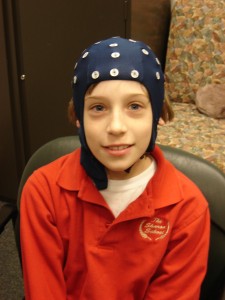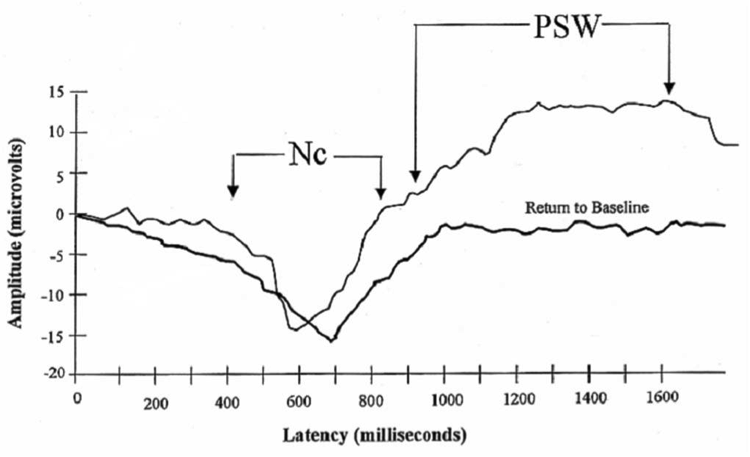Imaging Emotion and Memory with Event-Related Potentials (ERPs)

Modeling our high-tech headgear!
One of the tools that we use to study emotional memory is event-related potentials, or ERPs. ERPs are scalp-recorded electrical activity that represent neural processing of discrete stimuli. Participants view stimuli such as emotional pictures, or cue-words that represent specific personal memories, and we compare the ERPs for different categories of emotional events (e.g., positive, negative, neutral). Further, we use the ERPs to examine the neural processes that support successful memory performance.

Schematic of an ERP Waveform
Remembering Emotional Pictures
Adults often have better memory for emotional experiences, such as weddings and car accidents, versus mundane experiences, such as driving to work or going to the grocery store. This “emotional memory enhancement” effect is apparent in both behavioral and brain responses. It has important influences on what is remembered and how those memories are experienced. In an ongoing series of studies, we are studying whether emotion effects on memory are consistent from middle childhood through early adulthood, or if they change during this period of development. Using ERPs, we can see if there are unique patterns of brain activity for emotional versus neutral experiences, whether that activity relates to behavioral responses, and whether it is different for children and adults.
In a prior study, we used ERPs to examine brain activity while 5- and 8-year-old children viewed emotional scenes for the first time, and then again during a later memory task. Behaviorally, children’s memory was very good overall and it did not differ for emotional and neutral pictures. However, children had larger brain responses for emotional scenes (positive and negative) than for neutral scenes. This suggests to us that the “emotion effect” emerges earlier in the brain than in behavior. You can read about these findings in Leventon, Stevens, & Bauer (2014).
In a different study, we examined how modifying the emotionality of a scene impacts memory. We used a technique called reappraisal to prompt participants to perceive scenes as more or less emotional than they typically would. For example, a picture of a car falling off a cliff typically evokes a negative response. However, when accompanied by the explanation that it is a picture of a stunt car in an action movie, the image is reappraised and becomes less negative. The results from this study indicated that emotion enhances memory in school-age children. Importantly, the study also showed that manipulating emotion responses affects memory in school-age children. You can read about these findings in Leventon & Bauer (2016).
In an ongoing study, children between 8- and 16-years old and adults between 18- and 30-years old are asked to look at emotional scenes while wearing ERP caps. Data collection is now complete for 8- to 22-year-olds. Across this age range, participants remembered both negative and positive scenes better than neutral images. This “emotional memory enhancement” effect is strong and consistent at all ages. Preliminary analyses of the ERP data show that the brain response to emotional versus neutral scenes is also similar from middle childhood to early adulthood.
Together, these findings suggest that emotion effects on memory are stable and strong from middle childhood to early adulthood. The next step in this research is an examination of individual differences in memory for emotional relative to neutral scenes, in order to learn more about variability in sensitivity to emotional information.